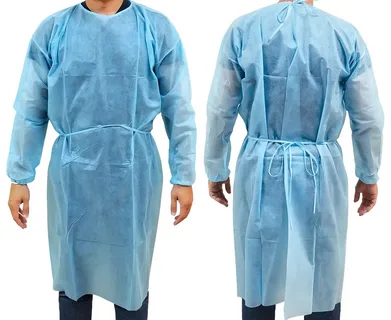In a world where safety and hygiene have taken centre stage, disposable gown has become essential in various industries. Imagine stepping into a space with a high risk of contamination; having the right gear can mean the difference between safety and exposure. Single-use gowns are not just for healthcare professionals—they serve as your first defence against harmful pathogens and contaminants. Whether in a hospital, laboratory, or even at home during DIY projects, understanding the role of single-use gowns can empower you to make informed choices about protection. Let’s dive deeper into why these seemingly simple garments are crucial for ultimate protection.
What Is A Single-Use Gown And Why It’s Essential For Protection?
A single-use gown is a single-use garment that provides a barrier between the wearer and potential contaminants. Made from lightweight, fluid-resistant materials, these gowns are vital in various settings where cleanliness is paramount.
They protect against spills, splashes, and other hazardous substances that could compromise safety. This makes them critical in hospitals, laboratories, food processing facilities, and even during specific home projects.
The essence of a single-use gown lies in its convenience and effectiveness. Since they are meant for one-time use, there’s no need for laundering or prolonged storage—wear them when needed and dispose of them properly afterwards.
Key Features of a High-Quality Single-Use Gown
A high-quality single-use gown should be made from durable, non-woven materials that provide excellent barrier protection.
Strong and Durable Materials
A high-quality single-use gown should be made from strong and durable materials such as polypropylene or spunbond-meltblown-spunbond (SMS) fabric. These materials resist tears, punctures, and fluid penetration, providing excellent barrier protection.
Fluid Resistance
The gown should be highly fluid-resistant to protect the wearer from exposure to bodily fluids and other potentially infectious substances.
Breathability
Despite its strong barrier properties, a suitable single-use gown should also be breathable to prevent heat and moisture buildup, which can make the wearer uncomfortable.
Comfortable Fit
The gown should be designed with comfort in mind, with features such as elastic cuffs and waistbands for a secure fit without restricting movement.
Full Coverage
The gown should cover the entire body, including the arms and legs, to minimize skin exposure.
Secure Closures
The gown’s closures, such as ties or Velcro fastenings, should be secure and easy to use to ensure proper coverage and prevent accidental openings.
Choosing the Right Single-Use Gown For Different Industries
Selecting the appropriate single-use gown varies by industry, each with unique requirements. In healthcare settings, gowns must meet strict fluid resistance and microbial barrier protection guidelines. Look for options that are compliant with regulatory standards to ensure maximum safety.
Lightweight and breathable materials are ideal for food processing or handling sectors. These gowns help maintain hygiene while allowing comfort during prolonged wear. Opting for a gown designed specifically for food services can effectively prevent cross-contamination. In industrial environments, ruggedness is key. Choose gowns made from durable materials that guard against chemicals and physical hazards. A well-fitted single-use gown ensures both safety and mobility in demanding conditions.
How Single-Use Gowns Help In Infection Control?
Single-use gowns serve as a crucial barrier against the transmission of infections in various settings. By providing full-body coverage, they prevent pathogens from coming into contact with skin and clothing. This is especially vital in environments where bodily fluids are exposed daily.
When healthcare workers don single-use gowns, they significantly reduce the risk of contamination during procedures. The material often used is fluid-resistant, which adds another layer of protection against spills and splashes that could harbour harmful bacteria or viruses.
Moreover, these gowns are designed for single use, ensuring that contaminants are disposed of properly after each encounter. This practice minimizes the chance of cross-contamination between patients and staff, promoting a safer environment for everyone involved.
Single-Use Gowns in Healthcare: A Critical Safety Measure
Single-use gowns play a vital role in healthcare settings. They provide an essential barrier between healthcare workers and potential contaminants, protecting staff and patients from infections. In environments where exposure to blood or bodily fluids is possible, wearing a single-use gown becomes crucial.
These garments are designed for single use, minimizing the risk of cross-contamination. Hospitals require strict adherence to safety protocols, making single-use gowns a standard part of personal protective equipment (PPE). Their lightweight material also allows for ease of movement while offering robust protection. This combination helps healthcare professionals focus on providing care without the distraction of worrying about contamination risks.
Why A Disposable Gown Is Your Best Defense Against Contamination?
When combating contamination, a single-use gown is your most reliable ally. These garments offer a barrier that protects both the wearer and the environment from harmful agents. They are designed to be lightweight yet robust, making them comfortable for extended wear while still providing essential coverage. Single-use gowns are crafted from materials that repel fluids and particulates, ensuring minimal risk of exposure in high-stakes settings.
This functionality is crucial not just in healthcare but also in various industries where cleanliness is paramount. Think about laboratories or food processing plants; here, every layer of protection counts. Moreover, the convenience factor must be considered. Single-use gowns eliminate the need for laundering and maintenance, allowing users to focus on their primary tasks without additional worry about cleaning protocols.
Simply donning a fresh gown before entering an area prone to contamination can significantly reduce risks associated with infectious diseases or hazardous substances. In essence, wearing a disposable gown equips you with peace of mind while safeguarding those around you. It’s more than just an article of clothing; it’s part of an essential strategy for maintaining hygiene and preventing contamination across diverse environments.
The Benefits of Wearing a Single-Use Gown in High-Risk Environments
Wearing a single-use gown in high-risk environments protects against pathogens and contaminants. These gowns create a barrier between the wearer and potential threats, minimizing exposure to harmful substances. This is especially vital in settings like healthcare facilities or laboratories.
Another key benefit of single-use gowns is their convenience. They are designed for single-use, allowing professionals to easily don them when needed and discard them without worrying about laundry or sterilization processes. This saves time and reduces the risk of cross-contamination. Single-use gowns promote compliance with safety regulations. In industries where hygiene standards are stringent, these garments help ensure that workers adhere to protocols effectively, reducing the likelihood of spreading infection among staff and patients.
How to Properly Dispose Of Your Single-Use Gown after Use?
Proper disposal of your single-use gown is crucial for maintaining a safe environment. After use, carefully remove the gown by pulling it away from your body without touching the outside surface. This helps to avoid any contamination. Next, roll the gown inside out as you remove it, ensuring that any potentially contaminated areas are enclosed. It’s essential to handle it carefully during this process to minimize exposure.
Place the rolled-up gown in an appropriate waste container designated for hazardous or biohazardous materials. Always follow local regulations regarding medical waste disposal to ensure compliance and safety. Proper disposal protects individuals and public health while preventing cross-contamination risks.
Understanding the Role of Single-Use Gowns in Preventing Cross-Contamination
Single-use gowns play a crucial role in preventing cross-contamination in various settings. Creating a barrier between the wearer and potential contaminants, these gowns help minimize the risk of spreading harmful pathogens. This is particularly vital in hospitals, laboratories, and food service areas.
Professionals wearing single-use gowns significantly reduce direct contact with infectious materials. The single-use nature of these garments ensures that once they are removed, any contaminated surface or material stays contained within the gown itself. Moreover, by utilizing single-use gowns appropriately, organizations can maintain higher hygiene standards. This protects individual health and safeguards public safety by preventing outbreaks from occurring due to careless practices.
Conclusion
Disposable gowns serve as a vital line of defence against contamination and infection. Their importance spans various industries, particularly in healthcare settings where safety protocols are paramount. By selecting high-quality options and understanding proper disposal methods, individuals can significantly reduce the risk of cross-contamination. The benefits of wearing single-use gowns cannot be overstated—they provide essential protection for both wearers and those they care for. Investing in these garments is necessary to ensure a safer environment for everyone involved.
FAQs
Single-use gowns are crucial for maintaining safety and hygiene in various settings. They provide a barrier against contamination, protecting both the wearer and others from potential hazards. Their disposable nature ensures they can be easily discarded after use, reducing the risk of cross-contamination. Understanding their importance helps individuals make informed decisions, especially in healthcare environments with heightened risk.
What materials are disposable gowns made of?
Disposable gowns are typically made from lightweight, non-woven fabrics like polypropylene or polyethylene. These materials offer protection while ensuring breathability.
Can single-use gowns be reused?
No, single-use gowns are designed for single use only to prevent contamination and ensure maximum protection.
Are there different types of single-use gowns available?
Several types are tailored for specific industries, such as healthcare, food handling, and industrial applications. Each type offers varying levels of protection based on its intended use.
| Related Business Listings |
| Contact Directory |
| Local Business Profiles |




